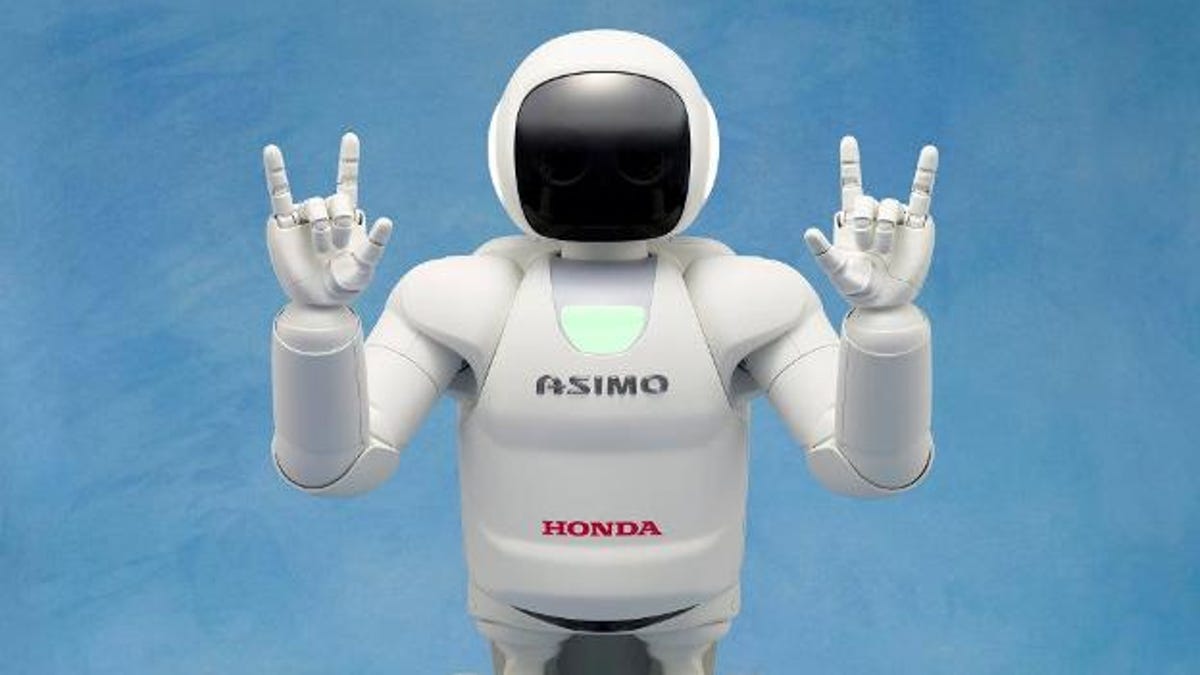Asimo does bottles, lovey-dovey hand gestures
In an update to Honda's humanoid robot, Asimo gets faster and more autonomous--and starts pouring drinks.

Honda's humanoid robot Asimo can now run faster, hop around, autonomously avoid people, and communicate in sign language with its new hands.
In the first major update to the droid in four years, Asimo has improved AI skills, being able to operate continuously without human control, and also has better locomotion, and a remarkable 57 axes of movement.
It's another step in the multimillion dollar, decades-old effort to make Asimo, first unveiled 12 years ago, useful. It also follows criticism of Japan's robotics community for a limp response to the Fukushima nuclear crisis.
"The all-new Asimo is now advanced from an 'automatic machine' to an 'autonomous machine' with the decision-making capability to determine its behavior in concert with its surroundings such as movements of people," Honda said.
Honda president Takanobu Ito showed off the upgraded droid at Honda R&D's Fundamental Technology Research Center in Wako, Saitama Prefecture near Tokyo.
With data from preset space sensors, Asimo can change its course to avoid an approaching person. It can also recognize the voices of multiple people speaking simultaneously.
Honda boosted the robot's control and balance technology, allowing Asimo to hop on one or two legs, run at 9 kph (5.6 mph) instead of only 6 kph, and walk over uneven surfaces. Check out the vid below.
The humanoid is also lighter, tipping the scales at 48 kg (105 pounds), 6 kg less than the last generation.
With better motor skills comes better dexterity. Honda has revamped Asimo's hands, adding 23 degrees of freedom over the previous model. Each finger can move independently and is embedded with a tactile sensor and a force sensor.
Asimo has been able to carry drink trays around for some time (I once had the pleasure of being served tea by Asimo in Tokyo), but now it can open bottles and pour liquids into paper cups without crushing them.
Another skill: robot sign language. Asimo can sign for "I love you" (above), and kazoku (family) in Japanese.
In a belated response to the lack of robots at Japan's many nuclear power plants, Honda also introduced a self-propelled articulated robot arm based on Asimo technology that can be used in disaster sites.
Weighing 29.5 kg (65 pounds) and sporting 10 axes of movement, the arm can be "remotely controlled to approach the object and stably perform necessary tasks even in a narrow space with unstable footing and many obstacles," Honda said.
Significantly, it can open and close valves on pipes, which might help prevent more nuclear meltdowns of the kind seen at Fukushima.
Underscoring its desire to revitalize its robot prowess, Honda also inaugurated a new name, Honda Robotics, for all its robot-related technologies and applications including mobility devices such as the unicycle-like U3-X.
"Striving to offer next-generation mobility products which expand the joy and fun of mobility, Honda will continue the robotics research that leads to Asimo, walking assist devices, U3-X and other technologies," the company said. "In addition, Honda will also work proactively toward putting such product applications into practical use."
After decades of cute machines developed at the expense of ignoring some critical real-world applications, will "practical" become a watchword for all robots in Japan? If so I'll gladly welcome them as overlords.

